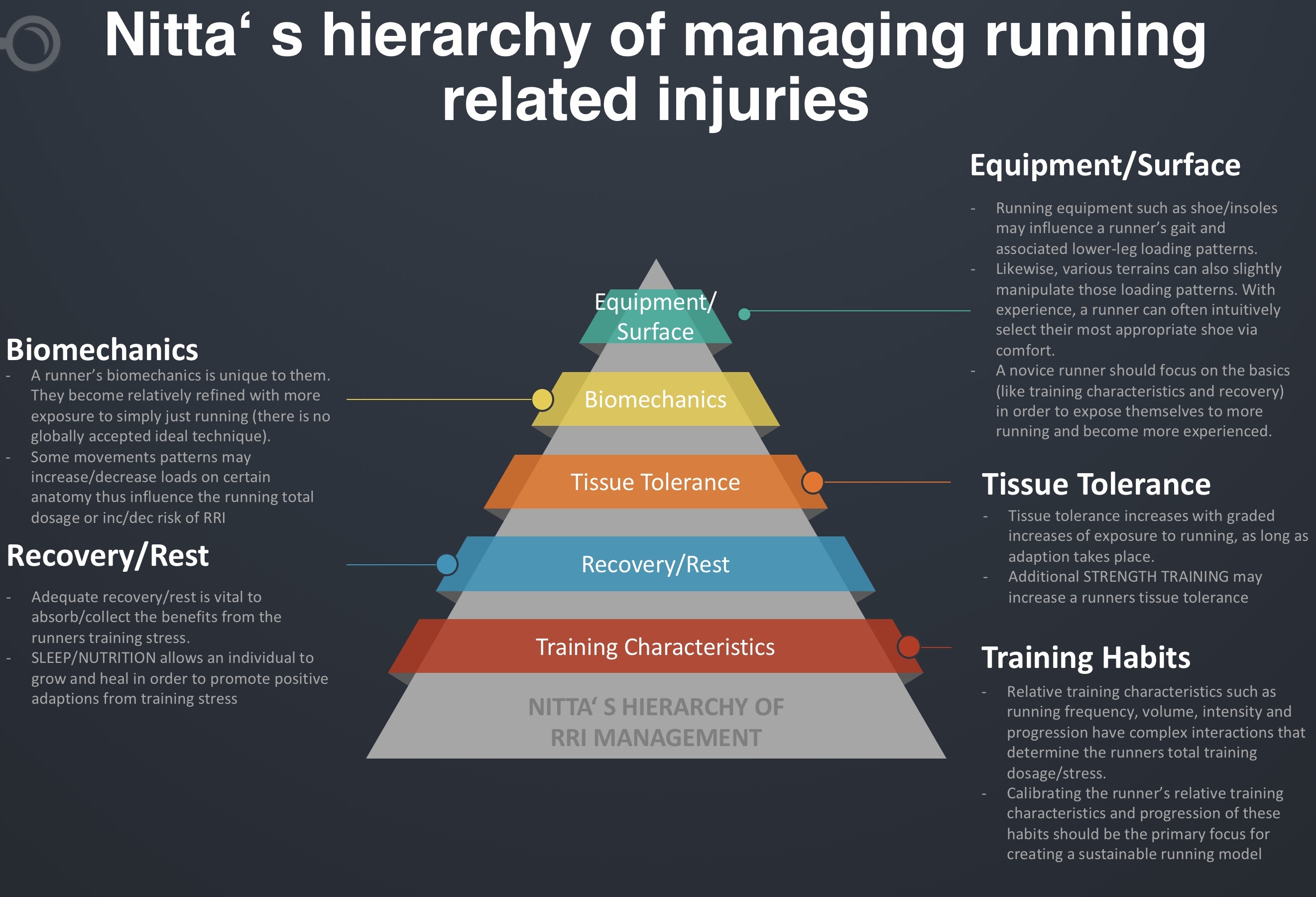Hierarchy of managing the runner - Part 1
Posted on July 25, 2019Trying to improve yourself as a runner can be a tricky equation. Improvement simply begins with trying to create consistent training habits that lead to positive training adaptations. However, it is that consistent training that tends to be anything but simple.
The common limitation to consistent training is running related injury (RRI), with incidence rates ranging from 2.5-33.0 injuries per 1000 hours of running exposure (Videbaek et al., 2015). When we consider incidence of injury relative to running exposure, novice runners are more susceptible to RRI (Kluitenberg et el., 2015) and 30% of novice runners report quitting running with 6 months and RRI is cited as the main reason (Fokkema et al., 2018). However, we still tend to see more injuries in sub-elite/elite runners as their training exposure if far greater, and this is important injury/illness is associated with not reaching their performance goals (Raysmith & Drew, 2016).
So what it the cause of RRI? Is it poor footwear? Is it poor running technique? Not enough stretching? These are reasons that are often perceived by runners that ‘cause RRI’, yet it’s a lot more broad than that. RRI is multifactorial, but it has been suggested that perhaps most RRI can be attributed to ‘training errors’ (Hreljac, 2005). So, what’s a training error? A training error isn’t really defined clearly, but usually is something that leads to a disturbance of the balance between stress and rest (too much too soon). A training error that leads to a RRI more than likely requires a complex system model to solve the problem, in order to create an optimal intervention (Bittencourt, 2016). There is very rarely there is an isolated risk factor and thus no ‘silver bullet’ solution to eliminate RRI. If there was an isolated risk factor, incidence rates would have decreased by now (which clearly have not). To suggest a RRI can be prevented seems a bit far fetched, however we have knowledge of factors that increase risk. Unfortunately, even education in knowing what may increase risk of RRI does not necessarily protect individuals from getting injured (Fokkema et al 2019). Humans may make a training error even though they know it is an error prior to still making it.
So after 20 years of physically running, and 13 years working with runners as a clinician and now moving to practically coaching runners, my approach to working in this field has evolved. I consider my role as an educator that attempts to create a sustainable running model that reduces risk of injury or overtraining syndrome for the individual. Along the way, hopefully create a very self-efficacious runner who can maintain this with less assistance in the future.
So this series of blogs goes on to discuss what I consider a hierarchy I follow to create a sustainable running training model. We will also have insight provided by our Sports Physicians on these topics to come.

Figure 1. Nitta’s hierarchy of sustainable running
Simply put, one cannot sustain a running related injury without performing the act of running itself. If you buy a shoe that isn’t your ideal, or you have poor strength/flexibility and/or running biomechanics, these ‘MAY’ increase your risk of a running injury but you still need run in order to get a RRI. The above hierarchy of managing sustainable running was designed to prioritise what risk-factors I clinically tend see as most important to reduce risk of injury (training characteristics [training stress] & adaptation [rest]). The hierarchy still places a focus on factors that may increase risk of injury, however I do not tend to consider these factors determining IF one will get injured, but perhaps more so WHAT may be get injured. I also consider these are factors that can dictate the DOSAGE of running one can handle (tissue tolerance, biomechanics & equipment).
Next: Part 2 – A look into training habits. Why organisation of your training characteristics may be the most important consideration for consistent running.
Nitta
Certified Sports Podiatrist & Middle/Long distance running coach
REFERENCES:
Videbaek, S., Bueno, A. M., Nielsen, R. O., & Rasmussen, S. (2015). Incidence of Running-Related Injuries Per 1000 h of running in Different Types of Runners: A Systematic Review and Meta-Analysis. Sports Med, 45(7), 1017-1026. doi: 10.1007/s40279-015-0333-8
Kluitenberg, B., van Middelkoop, M., Diercks, R., & van der Worp, H. (2015). What are the differences in injury proportions between different populations of runners? A systematic review and meta-analysis. Sports Med, 45. doi: 10.1007/s40279-015-0331-x
Fokkema, T., Hartgens, F., Kluitenberg, B., Verhagen, E., Backx, F. J. G., van der Worp, H., . . . van Middelkoop, M. (2018). Reasons and predictors of discontinuation of running after a running program for novice runners. Journal of Science and Medicine in Sport. doi: https://doi.org/10.1016/j.jsam...
Raysmith, B. P., & Drew, M. K. (2016). Performance success or failure is influenced by weeks lost to injury and illness in elite Australian track and field athletes: A 5-year prospective study. Journal of Science and Medicine in Sport, 19(10), 778-783. doi: https://doi.org/10.1016/j.jsam...
Bittencourt, N. F., Meeuwisse, W. H., Mendonca, L. D., Nettel-Aguirre, A., Ocarino, J. M., and Fonseca, S. T. (2016). Complex systems approach for sports injuries: moving from risk factor identification to injury pattern recognition-narrative review and new concept. Br. J. Sports Med. 50, 1309–1314. doi: 10.1136/bjsports-2015-095850
Hreljac, A. (2005). Etiology, Prevention, and Early Intervention of Overuse Injuries in Runners: a Biomechanical Perspective. Physical Medicine and Rehabilitation Clinics, 16(3), 651-667. doi: 10.1016/j.pmr.2005.02.002
Fokkema T, de Vos R, van Ochten JM, et al Online multifactorial prevention programme has no effect on the number of running-related injuries: a randomised controlled trial British Journal of Sports Medicine Published Online First: 06 April 2019. doi: 10.1136/bjsports-2018-099744

